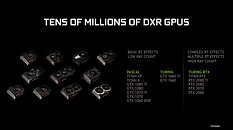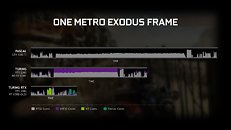Monday, March 18th 2019

NVIDIA to Enable DXR Ray Tracing on GTX (10- and 16-series) GPUs in April Drivers Update
NVIDIA had their customary GTC keynote ending mere minutes ago, and it was one of the longer keynotes clocking in at nearly three hours in length. There were some fascinating demos and features shown off, especially in the realm of robotics and machine learning, as well as new hardware as it pertains to AI and cars with the all-new Jetson Nano. It would be fair to say, however, that the vast majority of the keynote was targeting developers and researchers, as usually is the case at GTC. However, something came up in between which caught us by surprise, and no doubt is a pleasant update to most of us here on TechPowerUp.
Following AMD's claims on software-based real-time ray tracing in games, and Crytek's Neon Noir real-time ray tracing demo for both AMD and NVIDIA GPUs, it makes sense in hindsight that NVIDIA would allow rudimentary DXR ray tracing support to older hardware that do not support RT cores. In particular, an upcoming drivers update next month will allow DXR support for 10-series Pascal-microarchitecture graphics cards (GTX 1060 6 GB and higher), as well as the newly announced GTX 16-series Turing-microarchitecture GPUs (GTX 1660, GTX 1660 Ti). The announcement comes with a caveat letting people know to not expect RTX support (think lower number of ray traces, and possibly no secondary/tertiary effects), and this DXR mode will only be supported in Unity and Unreal game engines for now. More to come, with details past the break.NVIDIA claims that DXR mode will not run the same on Pascal GPUs relative to the new Turing GTX cards, primarily given how the Pascal microarchitecture can only run ray tracing calculations in FP32 mode, which is slower than what the Turing GTX cards can do via a combination of FP32 and INT32 calculations. Both will still be slower and less capable of hardware with RT cores, which is to be expected. An example of this performance deficit is seen below for a single frame from Metro Exodus, showing the three different feature sets in action.Dragon Hound, an MMO title shown off before by NVIDIA at CES, will be among the first game titles, if not the very first, to enable DXR support for the aforementioned GTX cards. This will be followed by other game titles that already have NVIDIA RTX support, including Battlefield V and Shadow of the Tomb Raider, as well as synthetic benchmarks including Port Royal. General incorporation into Unity and Unreal engines will help a lot coming forward, and NVIDIA then mentioned that they are working with more partners across the board to get DXR support going. Time will tell how well these implementations go, and the performance deficit coming with them, and we will be sure to examine DXR in the usual level of detail TechPowerUp is trusted for. But for now, we can all agree that this is a welcome move in greatly increasing the number of compatible devices capable for some form of real-time ray tracing, which in turn will enable game developers to focus on implementation as well now that there is a larger market.
Following AMD's claims on software-based real-time ray tracing in games, and Crytek's Neon Noir real-time ray tracing demo for both AMD and NVIDIA GPUs, it makes sense in hindsight that NVIDIA would allow rudimentary DXR ray tracing support to older hardware that do not support RT cores. In particular, an upcoming drivers update next month will allow DXR support for 10-series Pascal-microarchitecture graphics cards (GTX 1060 6 GB and higher), as well as the newly announced GTX 16-series Turing-microarchitecture GPUs (GTX 1660, GTX 1660 Ti). The announcement comes with a caveat letting people know to not expect RTX support (think lower number of ray traces, and possibly no secondary/tertiary effects), and this DXR mode will only be supported in Unity and Unreal game engines for now. More to come, with details past the break.NVIDIA claims that DXR mode will not run the same on Pascal GPUs relative to the new Turing GTX cards, primarily given how the Pascal microarchitecture can only run ray tracing calculations in FP32 mode, which is slower than what the Turing GTX cards can do via a combination of FP32 and INT32 calculations. Both will still be slower and less capable of hardware with RT cores, which is to be expected. An example of this performance deficit is seen below for a single frame from Metro Exodus, showing the three different feature sets in action.Dragon Hound, an MMO title shown off before by NVIDIA at CES, will be among the first game titles, if not the very first, to enable DXR support for the aforementioned GTX cards. This will be followed by other game titles that already have NVIDIA RTX support, including Battlefield V and Shadow of the Tomb Raider, as well as synthetic benchmarks including Port Royal. General incorporation into Unity and Unreal engines will help a lot coming forward, and NVIDIA then mentioned that they are working with more partners across the board to get DXR support going. Time will tell how well these implementations go, and the performance deficit coming with them, and we will be sure to examine DXR in the usual level of detail TechPowerUp is trusted for. But for now, we can all agree that this is a welcome move in greatly increasing the number of compatible devices capable for some form of real-time ray tracing, which in turn will enable game developers to focus on implementation as well now that there is a larger market.





113 Comments on NVIDIA to Enable DXR Ray Tracing on GTX (10- and 16-series) GPUs in April Drivers Update
So locked out yes, but it ain't artificial :laugh:
trog
This will be akin to the disaster that was the employment of PhysX in the early days on GPU. Back then it was a slide show basically on a number of titles. I don’t expect this to be much better.
I wouldn’t be surprised if it is a ploy for them to say later “See, we told you. You need our RTX cards to do this right.”
Hopefully Metro: Exodus will get this support.
They might as well make a new game in that case.
I think what this is about is NVIDIA showing commitment to DXR because there aren't many developers actually interested in deploying it because so few people can actually use it. Because these cards they are adding support to are so crappy at doing it, this news won't support their cause.
Like some D3D12 technologies, DXR will stew in the background for a decade before it becomes remotely useful to the average gamer and thus, something developers need to pay mind to. Rasterization will remain king until then...and for a long time thereafter.
It doesn't actually require DX10 / 11 GPUs to run.
At least that is the case back when the game was released, I am not sure if they made a lot of changes to the game engine since then.
I take the geometry had to be reduced exponentially in order to have ray tracing without hardware support.
"- Boys, let's release this RTX we've been working on for a few years, we'll have it exclusively in the new cards, so we'll sell them for premium.
- Boss, it's not that great yet, our new hardware still isn't that capable of fast and proper implementation.
- Just do it, it will be the first hardware Ray Tracing bling-bling ever, it's a big deal. We'll get it working in a couple AAA games and people will jump into it.
(... few months later...)
- Boss, people aren't joining the RTX bandwagon... and they aren't really swapping Pascal for Turing.
- Well then execute plan B: unlock Ray Tracing for old Pascal.
- But boss, those have no Ray Tracing focused hardware, it will run tons even worse.
- Exactly, we'll make them feel that Pascal is ancient crap, and then they'll want to finally swap them for RTXs. At the same time we'll spread the name even more.
(... weeks later...)
- Boss, still not a big interest in RTX 2000 cards. What now?
- Fine, release the RTX 3000 series with proper improved RTX performance, we'll make RTX 2000 look like ancient crap in comparison, and RTX 3000 look like the second coming of baby Jesus."
Just like they said when they presented RTX, bringing a card to the market that can do Ray Tracing this "fast" (compared to before) is quite an achievement. Problem is: it's still not fast enough.
"- People, we made the impossible: a card that can finally do the legendary tech that is "Ray Tracing"! Behold!
- Cool!
(...) Ok, nevermind, it runs slow. And I can live without it for now, can barely see the difference anyway.
- No, you don't understand. This is dope engineering. If it wasn't for this new hardware, it would be a slideshow with your current card.
- Y, but it's still slow. Not appealing.
- Look, we'll show you. Let's test with your current card.
- Dude, please..."
if i were AMD, i just simply ditch this features for the moment and stay focus on the new arch development. Not Worth!